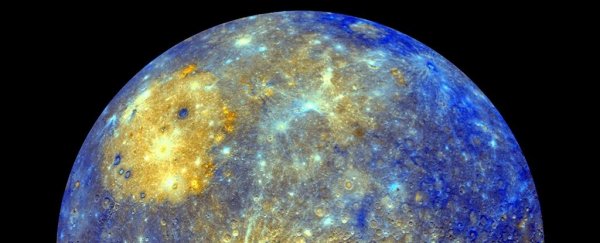Mercury is the innermost planet of the Solar System, taking just 88 Earth days to complete and orbit around the Sun, at an average distance of around 58 million kilometres.
At this close proximity, standing on the planet's surface the Sun would appear three times larger than it does from Earth.
Temperature on Mercury
Yet compared with the intensity of radiation reaching our planet, seven times the amount of sunlight washes over Mercury's day side, baking its surface to reach temperatures as high as 430 degrees Celsius (800 degrees Fahrenheit).
All this solar radiation blasting the planet also gives it a spectacular, comet-like tail that stretches for millions of kilometres.
Nov 10, 2020:
— Dr. Sebastian Voltmer (@SeVoSpace) November 15, 2020
That’s not a comet but the tail of our inner planet Mercury ”seen“ from my backyard. This stacked image was exposed through a custom-made Sodium filter. The horizon is from the first exposure.#mercury #spica #yellow #sodium #sodiumtail #spica #astronomy #science pic.twitter.com/vjpK3RAkeA
After sundown, the heat is quickly lost to the night. Mercury doesn't have an atmosphere to speak of - just a thin haze called an exosphere consisting of stray oxygen, sodium, hydrogen, helium, and potassium whipped up by occasional meteorite strikes and the solar wind.
Without an insulating blanket of gas to hold onto the warmth, temperatures can plummet as low as -180 degrees Celsius (around -290 degrees Fahrenheit).
Water ice on Mercury's surface
In the shadowed depths of select craters towards the poles, those ultra-freezing temperatures persist year round, providing shelter to patches of frost.
Ironically, it's the intense solar radiation itself that produces at least some of the ice, or at least its water, as protons on the Sun's wind collide with oxides in surface minerals to generate H2O molecules.
 Mercury's north pole. Yellow circles indicate evidence of water ice. (Johns Hopkins University/APL)
Mercury's north pole. Yellow circles indicate evidence of water ice. (Johns Hopkins University/APL)
Could humans one day survive on Mercury?
In spite of being so close to the Sun, and wild swings in extreme temperatures, humans could technically walk on the planet's surface.
Mercury's slow rotation means it takes 59 Earth days for it to turn around once. However, its relatively short year of 88 days means it takes just under 176 Earth days for it to complete a single cycle of day and night.
By following the terminator line - the slowly shifting twilight zone we experience as the Sun goes down - it's possible to avoid a roasting from sunlight as well as the insane cold.
 Illustration showing Mercury's terminator line, and its sodium tail in yellow. (NASA/JHU/APL/CIW/UoC)
Illustration showing Mercury's terminator line, and its sodium tail in yellow. (NASA/JHU/APL/CIW/UoC)
How would we get to Mercury?
The real problem would be working out a way to safely touch down. Having no atmosphere to use as a convenient brake would mean relying more on heavy fuels to control speed.
Though only a little larger than the Moon, Mercury has a whopping, huge iron core compared with its relatively thin crust, a mysterious feature that makes it incredibly heavy for its size. Such density means the planet's gravitational pull is just a third of Earth's - hardly crushing, but impressive given its barely 4,900 kilometres (around 3,000 miles) wide.
Then there's the issue of the journey itself. Putting aside the increasing levels of radiation as you approach the Sun, it would take six to seven years to navigate the complex trajectory necessary to intercept the planet. This is in spite of the fact that technically it could be considered our closest planetary neighbour.
Even without considering human passengers, it would be a feat. But sending a lander to Mercury could help us unravel many of its mysteries, and give us a new perspective on the Solar System's smallest planet.
All Explainers are determined by fact-checkers to be correct and relevant at the time of publishing. Text and images may be altered, removed, or added to as an editorial decision to keep information current.
